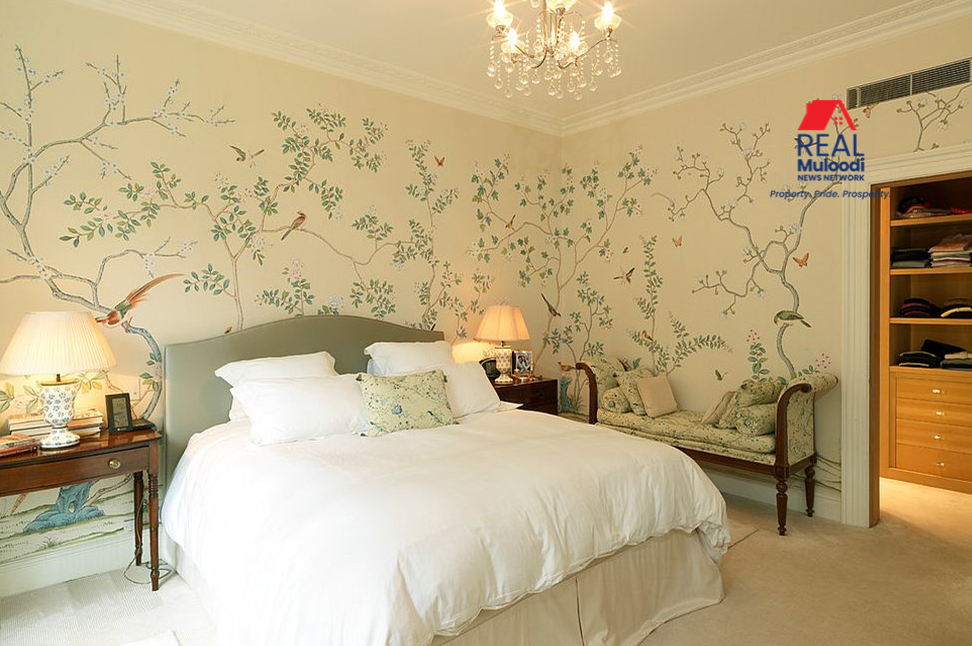UGANDA, Kampala | Real Muloodi News | House wallpapers are often overlooked, yet most people spend hours determining the perfect paint colour for every wall. Wallpapers can be just as important as paint because they bring character and personality to any room.
Over the years, the house wallpaper technique has evolved into new digital and 21st-century high-tech, such as silver ink-coated wallpapers that can block some Wi-Fi and cell phone signals for privacy.
Let’s look at the common house wallpaper types that can give any room that feeling of uniqueness and ambience.
Lining Wallpaper
As the name suggests, they use it as an underlayer for good surface preparation, especially over rough walls, before installing delicate wallpapers such as paper-backed foil.
Lining paper is an easy way to cover up imperfections on walls and ready them for painting. Depending on how terrible your walls are, choose different grades of lining paper and apply simple calculations to find out how many rolls you need. Carefully cut and paste the lining paper onto the walls, then wait for it to dry before painting.

Vinyl Wallpaper
This is pure vinyl laminated onto linen or paper backing. It is durable and easy to clean and can be used in children’s playrooms, and living rooms, among others.
Before pasting vinyl wallpaper, the wall should be free from old wallpaper, bumps, and imperfections and depending on the condition of the surface, it’s primed with a special primer.
Apply a primer designed only to treat surfaces before pasting wallpaper or any other primer with deep penetration.
Use the best glue designed for this type of wallpaper or the universal glue for other wallpapers.
Pasting vinyl wallpaper is not different from other wallpaper types. Always leave a few inches for trimming at the top and bottom of your wallpaper.

Vinyl Coated Wallpaper
This is wallpaper with a vinyl or acrylic coating on the front. Before applying the coat, the decorative design is first applied to the paper.
It is long-lasting, water-resistant, and stain-resistant, making it ideal for the kitchen and bathroom.

Embossed Wallpaper
This type of wallpaper has embossed graphics on one side and is hollow on the other, providing a textured impression. Embossed wallpaper is an embossed colour-patterned wallpaper with a decorative finish. Embossed wallpapers with no design except texture are called Anaglypta.
This house wallpaper is best suited for slightly damaged walls since the patterns perfectly cover imperfections.
When installing the embossed wallpaper, get a straight edge and sharp blade, cut vertically through the overlapping paper and peel back the top layer to remove the bottom strip. Smooth the surface with a textured wallpaper steam roller to make it uniform.

Metallic or Foil Wallpaper
Foil wallpapers are one of the most colourful, dramatic, and intriguing types of wallpapers available, but they’re also one of the most challenging to install.
They’re made of thin metallic foil that’s been screen-printed with various plain colours and designs. Foil papers have a considerable amount of metal on their surface, with aluminium being the most common metal used.
Designs are then printed on top of the dazzling metallic finish. If your wall is in poor condition, avoid using foil wallpaper because it highlights the flaws.
There are a few things to look out for when selecting a metallic wallpaper, such as natural light, type of room, and overall style. Some wallpapers can be used on every wall, while others look better on dramatic accent walls.

Borders Wallpaper
These are vinyl-coated strips commonly used along ceiling lines, baseboards, moulding chair rails, and around doors and windows.
They are available in unique designs and widths and can be used on walls covered with either wallpaper or paint to create contrast in the interior.

Fibreglass Wallpaper
This is a wallpaper made from glass fibres woven and bonded together. It is strong, flame resistant and a splendid solution to wall imperfections such as cracks, flaking paint and dampness.
You can use fibreglass wallpaper several times without getting worn out and is recommended for corporates, which need regular branding changes.

Wallpapers aren’t always just for decoration – some can act as wall insulation or wall protection too. The wallpaper reflects light differently than paint, so it’s important to match your wall coverings to the room they’re placed. For example, if you have a dark sofa in a dark room, wallpapers with lighter colours might look out of place.
Using colour to set the ambience of a room is a good idea. Choose patterns with cool-colour backgrounds, such as green, blue, or violet, to make a room appear larger and the ceiling appears taller.
Soft cool colours suggest tranquillity, while intense cool colours are fresh and dramatic. Warm colours such as red, yellow, and orange make the room feel warmer. The more intense the colour, the more excitement it will give to a room.
In a north-facing room, dark hallway, or windowless space, look for wallpapers that will reflect light around the room, such as patterns with light colours and those with metallic or iridescent inks.
Patterns with smooth surfaces that reflect more light should also be considered. Dark colours absorb light, making the room appear smaller, and the walls appear closer. Textured surfaces also give a wall a darker appearance.
You can use patterns with real or imagined texture to conceal or camouflage wall defects. Expanded vinyl, grass and string cloth, burlap, foil, and fabric are some examples of patterns with actual tactile surfaces. Other papers simulate marble, wood, leather, fabric, and even animal skins.
If you want to install the wallpaper yourself, follow the manufacturer’s instructions carefully for the best results since some materials are very delicate.
ADVERTISEMENT:
READ MORE LIKE THIS:
Soundproofing: Construction Methods and Materials for Noise Control




